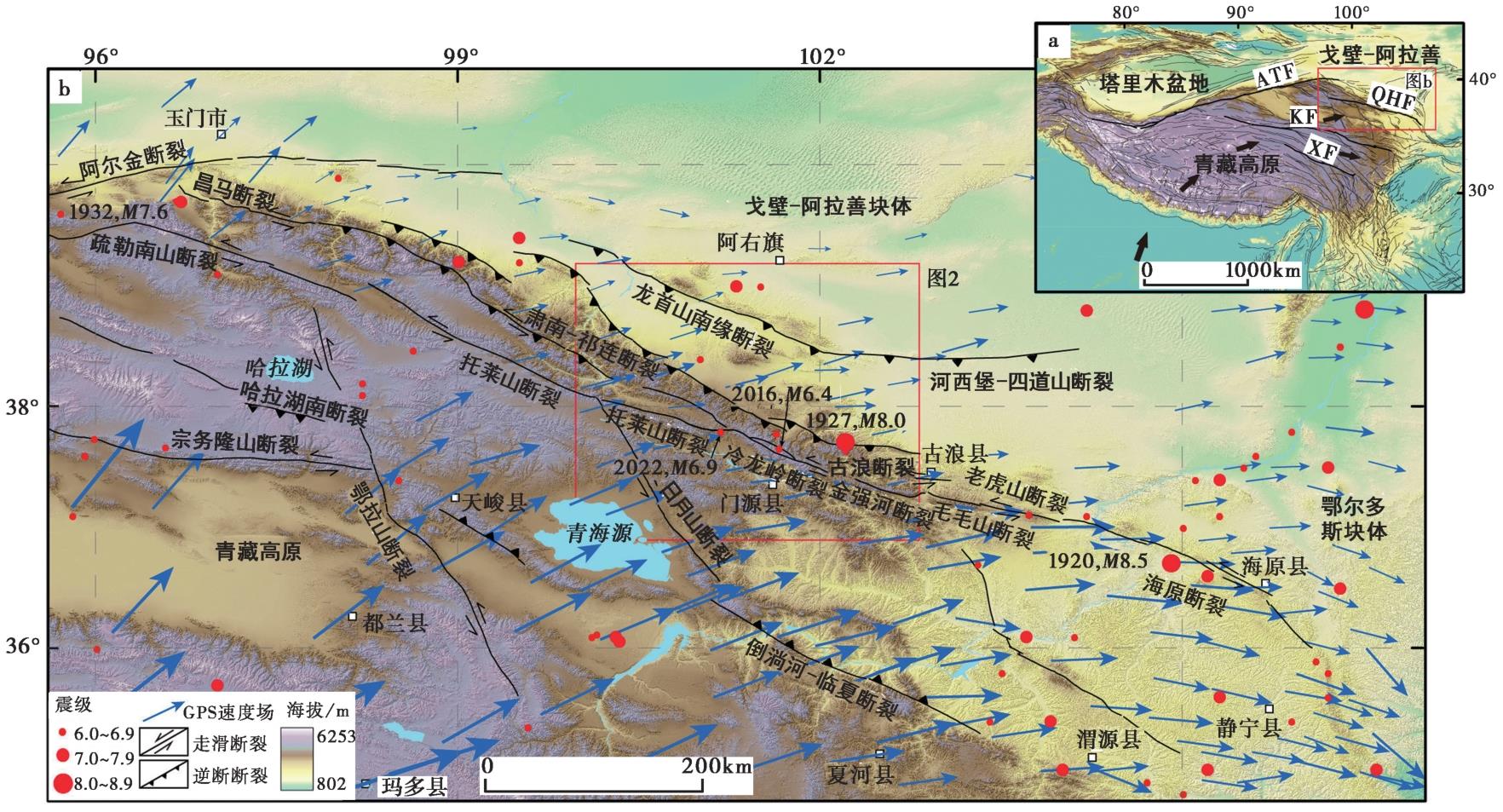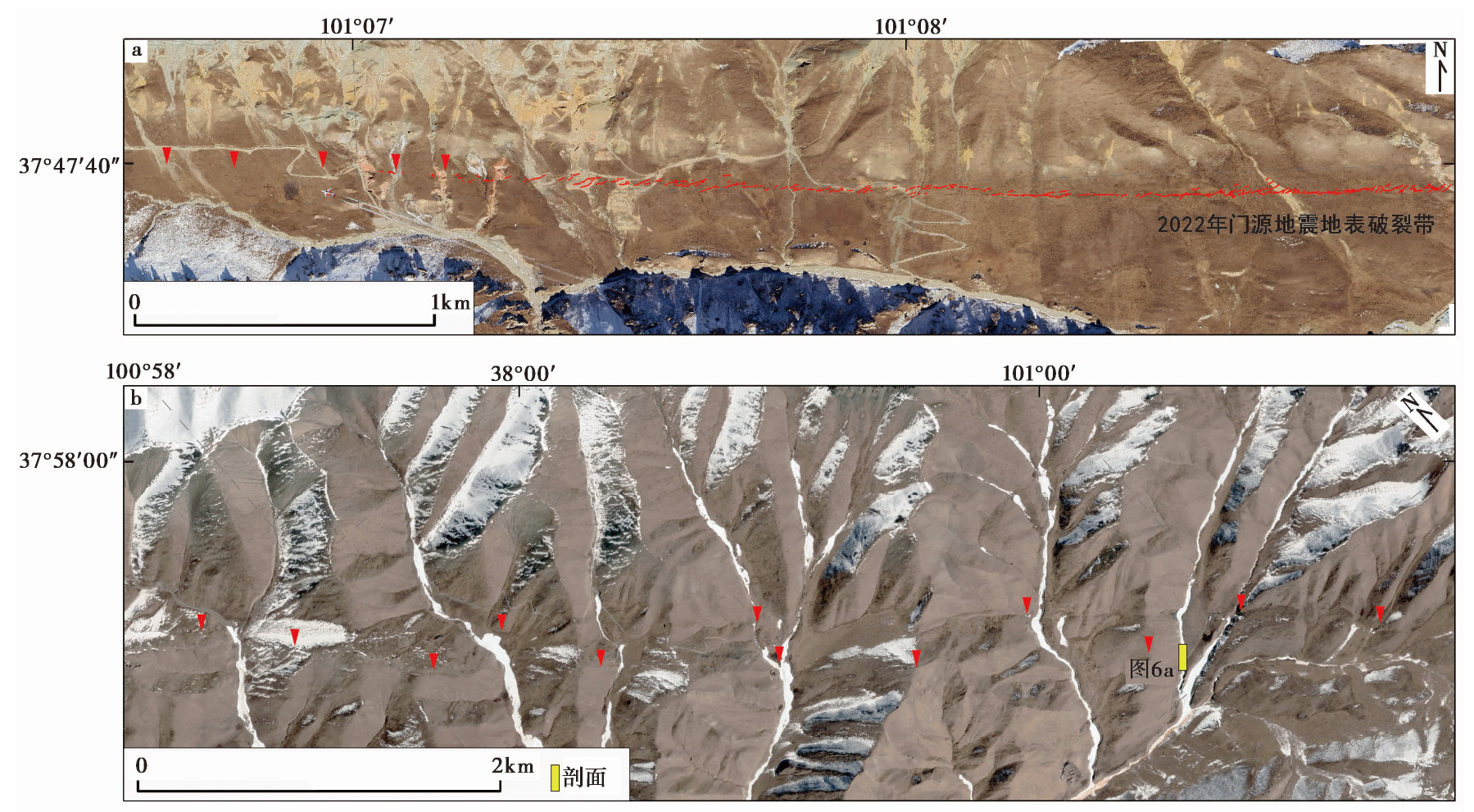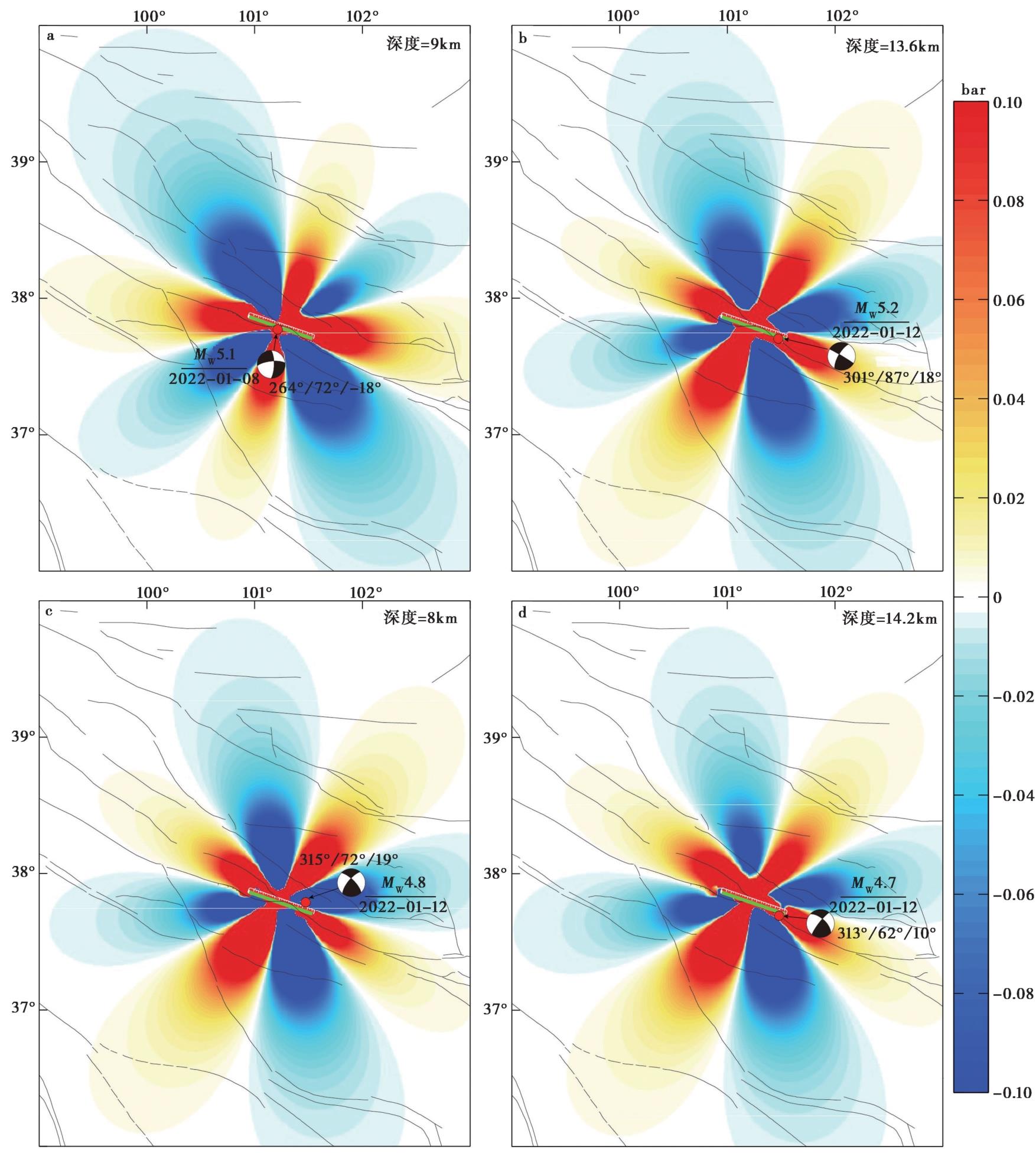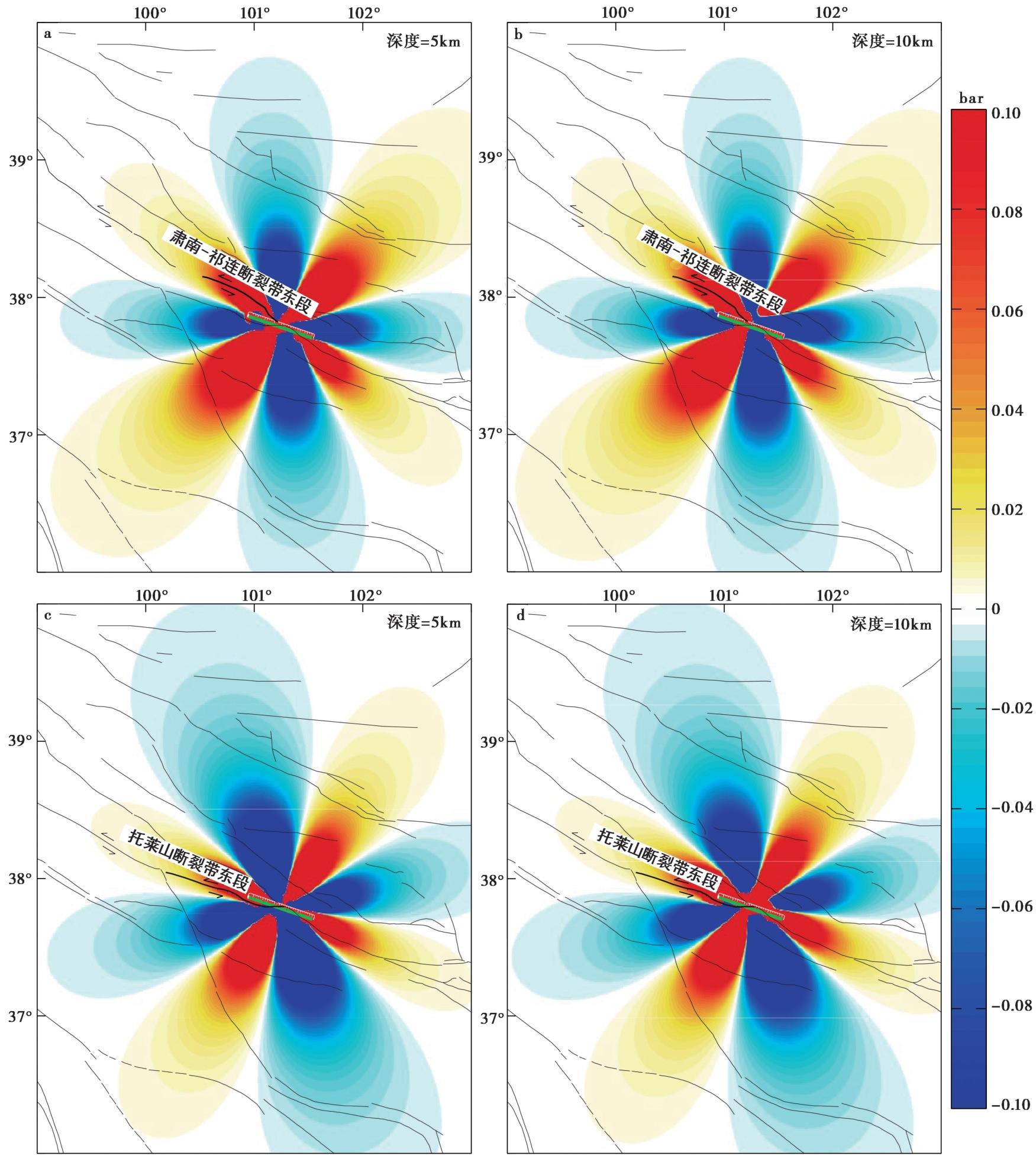地震地质 ›› 2025, Vol. 47 ›› Issue (1): 325-344.DOI: 10.3969/j.issn.0253-4967.2025.01.019
牛鹏飞( ), 韩竹军*(
), 韩竹军*( ), 郭鹏, 刘冠伸, 罗佳宏, 郭钊吾
), 郭鹏, 刘冠伸, 罗佳宏, 郭钊吾
收稿日期:2024-05-26
修回日期:2024-12-28
出版日期:2025-02-20
发布日期:2025-04-09
通讯作者:
韩竹军
作者简介:牛鹏飞, 男, 1995年生, 现为中国地震局地质研究所构造地质学专业在读博士研究生, 主要从事活动构造研究, E-mail: niupengfei0814@163.com。
基金资助:
NIU Peng-fei( ), HAN Zhu-jun*(
), HAN Zhu-jun*( ), GUO Peng, LIU Guan-shen, LUO Jia-hong, GUO Zhao-wu
), GUO Peng, LIU Guan-shen, LUO Jia-hong, GUO Zhao-wu
Received:2024-05-26
Revised:2024-12-28
Online:2025-02-20
Published:2025-04-09
Contact:
HAN Zhu-jun
摘要: 分析地震之间的应力传递有助于分析及评估未来强震危险性。2016年门源 MW5.9 地震和2022年门源 MW6.7 地震都发生在祁连-海原断裂带的冷龙岭段, 研究2次地震对西侧“托莱山地震空区”的库仑应力影响可为更深入认识区域强震危险性提供科学依据。文中基于库仑应力理论、USGS(美国地质调查局)给出的有限断层模型及现场调查确定的主要发震断层的几何学和运动学参数, 分析探讨了2016年地震对2022年地震的触发机制、2022年地震对区域强余震的库仑应力作用及2次地震对空区内主要发震断裂的影响。结果表明, 2016年地震对2022年地震具有触发作用。其中, 2022年1月8日和1月12日 MW5.1、MW5.2和 MW4.7 强余震明显受到1月8日 MW6.7 主震的应力触发, 2022年1月12日发生的 MW4.8 余震位于库仑应力卸载区, 主震产生的破裂延迟了 MW4.8 地震的发生; 2016年和2022年2次门源地震对托莱山断裂带东段和肃南-祁连断裂带东段有显著的库仑应力加载作用, 后者产生的库仑应力变化量为0.3891bar和0.1658bar, 高于一般认为的地震触发阈值(0.1bar)。综合分析强震空间迁移趋势、余震空间分布、应变分配、古地震研究等资料, 发现托莱山断裂带东段和肃南-祁连断裂带东段的应力积累可能处于较高的状态, 2次门源地震的库仑应力加载将进一步增加2条发震断裂带东段未来发生强震的危险性。
牛鹏飞, 韩竹军, 郭鹏, 刘冠伸, 罗佳宏, 郭钊吾. 青海门源2016年MW5.9和2022年MW6.7 2次地震的库仑应力触发作用及其对周边发震断裂的影响[J]. 地震地质, 2025, 47(1): 325-344.
NIU Peng-fei, HAN Zhu-jun, GUO Peng, LIU Guan-shen, LUO Jia-hong, GUO Zhao-wu. THE COULOMB STRESS TRIGGERING EFFECT OF 2016 MW5.9 AND 2022 MW6.7 EARTHQUAKES IN MENYUAN, QINGHAI AND THEIR INFLUENCE ON THE SURROUNDING SEISMOGENIC FAULTS[J]. SEISMOLOGY AND GEOLOGY, 2025, 47(1): 325-344.
| 序号 | 日期 | 震级 /MW | 震源深度 /km | 节面1 | 节面2 | 来源 | ||||
|---|---|---|---|---|---|---|---|---|---|---|
| 走向 /(°) | 倾角 /(°) | 滑动角 /(°) | 走向 /(°) | 倾角 /(°) | 滑动角 /(°) | |||||
| 1 | 2016-01-21 | 5.9 | 13.9 | 343 | 51 | 109 | 134 | 43 | 68 | GCMT |
| 2 | 2022-01-08 | 6.7 | 14.8 | 104 | 82 | 1 | 14 | 89 | 172 | |
表1 2次门源地震的断层模型
Table1 Fault models of the two Menyuan earthquakes
| 序号 | 日期 | 震级 /MW | 震源深度 /km | 节面1 | 节面2 | 来源 | ||||
|---|---|---|---|---|---|---|---|---|---|---|
| 走向 /(°) | 倾角 /(°) | 滑动角 /(°) | 走向 /(°) | 倾角 /(°) | 滑动角 /(°) | |||||
| 1 | 2016-01-21 | 5.9 | 13.9 | 343 | 51 | 109 | 134 | 43 | 68 | GCMT |
| 2 | 2022-01-08 | 6.7 | 14.8 | 104 | 82 | 1 | 14 | 89 | 172 | |

图1 青藏高原东北缘主要活动断裂带与地震(M≥6.0)震中分布图 a 红色方框为图b范围, 黑色箭头指示块体运动方向。QHF 祁连-海原断裂带; ATF 阿尔金断裂带; KF 昆仑断裂带; XF 鲜水河断裂带。b 断裂位置与性质据文献(徐锡伟等, 2016); 地震数据来自中国地震信息网, 相对于稳定欧亚大陆的GPS速度场来自文献(Zhao et al., 2015)
Fig. 1 Distribution of major active faults and epicenters of earthquakes(M≥6.0)on the northeastern margin of the Qinghai-Xizang Plateau.

图3 托莱山断裂带东段和肃南-祁连断裂带东段典型地表破裂迹线 卫星影像来自Google Earth。a托莱山断裂带的断错地貌及2022年门源地震地表破裂带迹线,分辨率为0.15m;b肃南-祁连断裂带断错地貌,分辨率为0.30m。
Fig. 3 Surface rupture traces of the eastern segment of the Tuolai Mountain fault zone and the eastern segment of the Sunan-Qilian fault zone.
| 序号 | 日期 | 发震时刻 | 震级 /MW | 震中位置 | 震源 深度 /km | 节面1 | 节面2 | 来源 | ||||
|---|---|---|---|---|---|---|---|---|---|---|---|---|
| 走向 /(°) | 倾角 /(°) | 滑动角 /(°) | 走向 /(°) | 倾角 /(°) | 滑动角 /(°) | |||||||
| 1 | 2022-01-08 | 02:09:05 | 5.1 | 101.217°E 37.773°N | 9 | 0 | 73 | -161 | 264 | 72 | -18 | 许英才等, |
| 2 | 2022-01-12 | 18:20:41 | 5.2 | 101.469°E 37.703°N | 13.6 | 210 | 72 | 177 | 301 | 87 | 18 | |
| 3 | 2022-01-12 | 20:16:18 | 4.8 | 101.470°E 37.780°N | 8 | 219 | 72 | 161 | 315 | 72 | 19 | |
| 4 | 2022-01-12 | 21:01:53 | 4.7 | 101.475°E 37.697°N | 14.2 | 218 | 81 | 152 | 313 | 62 | 10 | |
表2 2022年门源地震后续4次震级>MW4.5的强余震破裂参数
Table2 Rupture parameters of the four strong aftershocks greater than MW4.5 following the 2022 Menyuan earthquake
| 序号 | 日期 | 发震时刻 | 震级 /MW | 震中位置 | 震源 深度 /km | 节面1 | 节面2 | 来源 | ||||
|---|---|---|---|---|---|---|---|---|---|---|---|---|
| 走向 /(°) | 倾角 /(°) | 滑动角 /(°) | 走向 /(°) | 倾角 /(°) | 滑动角 /(°) | |||||||
| 1 | 2022-01-08 | 02:09:05 | 5.1 | 101.217°E 37.773°N | 9 | 0 | 73 | -161 | 264 | 72 | -18 | 许英才等, |
| 2 | 2022-01-12 | 18:20:41 | 5.2 | 101.469°E 37.703°N | 13.6 | 210 | 72 | 177 | 301 | 87 | 18 | |
| 3 | 2022-01-12 | 20:16:18 | 4.8 | 101.470°E 37.780°N | 8 | 219 | 72 | 161 | 315 | 72 | 19 | |
| 4 | 2022-01-12 | 21:01:53 | 4.7 | 101.475°E 37.697°N | 14.2 | 218 | 81 | 152 | 313 | 62 | 10 | |

图5 2022年门源地震对后续强余震的库仑应力作用 a MW5.1地震为接收断层; b MW5.2地震为接收断层; c MW4.8地震为接收断层; d MW4.7地震为接收断层
Fig. 5 Coulomb stress effect of the 2022 Menyuan earthquake on subsequent strong aftershocks.

图7 2022年门源地震对周边发震断裂的库仑应力影响 a、b 以肃南-祁连断裂带东段为接收断层; c、d 以托莱山断裂带东段为接收断层
Fig. 7 Influence of the 2022 Menyuan earthquake on the Coulomb stress of surrounding seismogenic faults.
| [1] |
程佳, 刘杰, 甘卫军, 等. 2011. 1997年以来巴颜喀拉块体周缘强震之间的黏弹性触发研究[J]. 地球物理学报, 54(8): 1997—2010.
|
|
|
|
| [2] |
盖海龙, 李智敏, 姚生海, 等. 2022. 2022年青海门源 MS6.9 地震地表破裂特征的初步调查研究[J]. 地震地质, 44(1): 238—255. doi: 10.3969/i.ssn.0253-4967.2022.01.015.
|
|
|
|
| [3] |
郭鹏, 韩竹军, 安艳芬, 等. 2017a. 冷龙岭断裂系活动性与2016年门源6.4级地震构造研究[J]. 中国科学(地球科学), 47(5): 617—630.
|
|
|
|
| [4] |
郭鹏, 韩竹军, 姜文亮, 等. 2017b. 青藏高原东北缘冷龙岭断裂全新世左旋滑动速率[J]. 地震地质, 39(2): 323—341. doi: 10.3969/j.issn.0253-4967.2017.02.005.
|
|
|
|
| [5] |
韩帅, 吴中海, 高扬, 等. 2022. 2022年1月8日青海门源 MS6.9 地震地表破裂考察的初步结果及对冷龙岭断裂活动行为和区域强震危险性的启示[J]. 地质力学学报, 28(2): 155—168.
|
|
|
|
| [6] |
韩竹军, 董绍鹏, 谢富仁, 等. 2008. 南北地震带北部5次(1561—1920年)M≥7地震触发关系研究 地球物理学报, 51( 6): 1776—1784.
|
|
|
|
| [7] |
雷东宁, 刘杰, 刘姝妹, 等. 2018. 2016年1月21日青海门源M6.4地震发震构造模式[J]. 地震地质, 40(1): 107—120. doi: 10.3969/j.issn.0253-4967.2018.01.009.
|
|
|
|
| [8] |
李振洪, 韩炳权, 刘振江, 等. 2022. InSAR数据约束下2016年和2022年青海门源地震震源参数及其滑动分布[J]. 武汉大学学报(信息科学版), 47(6): 887—897.
|
|
|
|
| [9] |
李智敏, 盖海龙, 李鑫, 等. 2022. 2022年青海门源 MS6.9 地震发震构造和地表破裂初步调查[J]. 地质学报, 96(1): 330—335.
|
|
|
|
| [10] |
梁宽, 何仲太, 姜文亮, 等. 2022. 2022年1月8日青海门源 MS6.9 地震的同震地表破裂特征[J]. 地震地质, 44(1): 256—278. doi: 10.3969/j.issn.0253-4967.2022.01.016.
|
|
|
|
| [11] |
刘方斌, 王爱国, 袁道阳. 2014. 北祁连山东段强震间静态库仑应力变化与触发作用研究[J]. 地震工程学报, 36(2): 360—371, 379.
|
|
|
|
| [12] |
刘建生, 刘百篪, 袁道阳. 1994. 肃南断裂晚第四纪活动特征及古地震初步研究 [G]//中国地震学会地震地质专业委员会. 中国活动断层研究. 北京: 地震出版社: 36—41.
|
|
|
|
| [13] |
牛鹏飞, 韩竹军, 郭鹏, 等. 2024. 2022年青海门源M6.9地震地表破裂带宽度调査与启示[J]. 地球物理学报, 67(2): 548—570.
|
|
|
|
| [14] |
潘家伟, 李海兵,
|
|
|
|
| [15] |
邵志刚, 周龙泉, 蒋长胜, 等. 2010. 2008年汶川 MS8.0 地震对周边断层地震活动的影响[J]. 地球物理学报, 53(8): 1784—1795.
|
|
|
|
| [16] |
沈正康, 万永革, 甘卫军, 等. 2003. 东昆仑活动断裂带大地震之间的黏弹性应力触发研究[J]. 地球物理学报, 46(6): 786—795.
|
|
|
|
| [17] |
石富强, 熊熊, 王朋涛, 等. 2023. 2016年以来门源2次6级地震的应力触发及其对祁连-海原断裂带地震危险性的指示[J]. 地球物理学报, 66(8): 3230—3241.
|
|
|
|
| [18] |
汤大委, 葛伟鹏, 袁道阳, 等. 2023. 青藏高原北部历史强震对2022年门源 MS6.9 地震及后续地震库仑应力触发作用[J]. 地球物理学报, 66(7): 2772—2795.
|
|
|
|
| [19] |
万永革. 2002. “地震静态应力触发”问题的研究[D]. 北京: 中国地震局地球物理研究所.
|
|
|
|
| [20] |
万永革, 黄少华, 王福昌, 等. 2023. 2022年门源地震序列揭示的断层几何形状及滑动特性[J]. 地球物理学报, 66(7): 2796—2810.
|
|
|
|
| [21] |
万永革, 沈正康, 盛书中, 等. 2009. 2008年汶川大地震对周围断层的影响[J]. 地震学报, 31(2): 128—139.
|
|
|
|
| [22] |
万永革, 沈正康, 曾跃华, 等. 2007. 青藏高原东北部的库仑应力积累演化对大地震发生的影响[J]. 地震学报, 29(2): 115—129.
|
|
|
|
| [23] |
徐晶, 邵志刚, 刘静, 等. 2017. 基于库仑应力变化分析巴颜喀拉地块东端的强震相互关系[J]. 地球物理学报, 60(10): 4056—4068.
|
|
|
|
| [24] |
徐锡伟, 韩竹军, 杨晓平, 等. 2016. 中国及邻近地区地震构造图[CM]. 北京: 地震出版社.
|
|
|
|
| [25] |
许英才, 郭祥云, 冯丽丽. 2022. 2022年1月8日青海门源 MS6.9 地震序列重定位和震源机制解研究[J]. 地震学报, 44(2): 195—210.
|
|
|
|
| [26] |
杨丽萍, 苏旭. 2017. 德令哈市地震小区划[M]. 北京: 地震出版社.
|
|
|
|
| [27] |
袁道阳, 谢虹, 苏瑞欢, 等. 2023. 2022年1月8日青海门源 MS6.9 地震地表破裂带特征与发震机制[J]. 地球物理学报, 66(1): 229—244.
|
|
|
|
| [28] |
张瑞, 张竹琪, 郑德文, 等. 2021. 鄂尔多斯活动地块西缘强震间库仑应力作用[J]. 地球物理学报, 64(10): 3576—3599.
|
|
|
|
| [29] |
张致伟, 龙锋, 石富强, 等. 2023. 2022年6月1日四川芦山 MS6.1 地震的发震构造与力学机制探讨[J]. 地球物理学报, 66(10): 4095—4110.
|
|
|
|
| [30] |
朱航, 闻学泽. 2012. 小江-则木河断裂带大地震序列的静应力触发作用[J]. 地球科学(中国地质大学学报), 37(1): 199—206.
|
|
|
|
| [31] |
朱琳, 戴勇, 石富强, 等. 2022. 祁连-海原断裂带库仑应力演化及地震危险性[J]. 地震学报, 44(2): 223—236.
|
|
|
|
| [32] |
|
| [33] |
|
| [34] |
|
| [35] |
|
| [36] |
|
| [37] |
|
| [38] |
|
| [39] |
|
| [40] |
|
| [41] |
|
| [42] |
|
| [43] |
|
| [44] |
|
| [45] |
|
| [46] |
|
| [47] |
|
| [48] |
|
| [49] |
|
| [50] |
|
| [51] |
|
| [52] |
|
| [53] |
|
| [54] |
|
| [55] |
|
| [56] |
|
| [57] |
|
| [58] |
|
| [59] |
|
| [60] |
|
| [61] |
|
| [62] |
|
| [63] |
|
| [64] |
|
| [1] | 徐晶, 季灵运, 刘传金. 2022年泸定MS6.8地震震前区域变形背景及同震形变特征[J]. 地震地质, 2024, 46(3): 645-664. |
| [2] | 于书媛, 黄显良, 郑海刚, 李玲利, 骆佳骥, 丁娟, 范晓冉. 2022年门源MW6.7地震的同震破裂模型及应力研究[J]. 地震地质, 2023, 45(1): 286-303. |
| [3] | 徐晓雪, 季灵运, 朱良玉, 王光明, 张文婷, 李宁. 漾濞MS6.4地震同震形变特征及发震构造探讨[J]. 地震地质, 2021, 43(4): 771-789. |
| [4] | 李玉江, 石富强, 张辉, 魏文薪, 徐晶, 邵志刚. 川滇地区主要断裂带上的库仑应力变化及其对地震危险性的指示[J]. 地震地质, 2020, 42(2): 526-546. |
| [5] | 张群伟, 朱守彪. 华北地区主要断裂带上的库仑应力变化及地震活动性分析[J]. 地震地质, 2019, 41(3): 649-669. |
| [6] | 姜文亮, 李永生, 田云锋, 韩竹军, 张景发. 冷龙岭地区2016年青海门源6.4级地震发震构造特征[J]. 地震地质, 2017, 39(3): 536-549. |
| [7] | 徐晶, 季灵运, 姬存伟, 孙赫, 赵强. 川滇菱形块体东边界断裂带内库仑应力演化及危险性[J]. 地震地质, 2017, 39(3): 451-469. |
| [8] | 缪淼, 朱守彪. 2014年鲁甸地震(MS=6.5)静态库仑应力变化及其影响[J]. 地震地质, 2016, 38(1): 169-181. |
| 阅读次数 | ||||||
|
全文 |
|
|||||
|
摘要 |
|
|||||